Integrating Augmented Reality, Gamification, and Serious Games in Computer Science Education
Abstract
1. Introduction
- RQ1: How often and on which devices do students mostly play games?
- RQ2: How did students evaluate the application in terms of usability and learnability?
- RQ3: What was the degree of competence, immersion, tension, flow, and challenge that students experienced when using the application?
- RQ4: Did the use of the application result in positive or negative effects on students and their learning experience?
- RQ5: What kind of motivation is mostly triggered when using the application as a learning tool?
- RQ6: Which emotions did students mostly feel when using the application as a learning tool?
- RQ7: To what degree does the application satisfy students’ innate need for autonomy, competence, and relatedness?
- RQ8: What were the educational benefits yielded when integrating the application?
2. Related Work
3. Materials and Methods
3.1. Development Process
3.2. Experiment
3.3. Research Tools
4. Result Analysis
4.1. Students’ Gaming Habits
4.2. System Usability Scale (SUS)
4.3. Game Experience Questionnaire (GEQ) In-Game Module
4.4. Game Experience Questionnaire (GEQ) Post-Game Module
4.5. Learning Motivations Promoted and Emotions Felt
4.6. Students’ Autonomy, Competence, and Relatedness—Self-Determination Theory (SDT)
4.7. Educational Benefits
5. Discussion
6. Conclusions
Author Contributions
Funding
Institutional Review Board Statement
Informed Consent Statement
Data Availability Statement
Acknowledgments
Conflicts of Interest
References
- Haleem, A.; Javaid, M.; Qadri, M.A.; Suman, R. Understanding the role of digital technologies in education: A review. Sustain. Oper. Comput. 2022, 3, 275–285. [Google Scholar] [CrossRef]
- Bygstad, B.; Øvrelid, E.; Ludvigsen, S.; Dæhlen, M. From dual digitalization to digital learning space: Exploring the digital transformation of higher education. Comput. Educ. 2022, 182, 104463. [Google Scholar] [CrossRef]
- Lampropoulos, G.; Anastasiadis, T.; Siakas, K. Digital game-based learning in education: Significance of motivating, engaging and interactive learning environments. In Proceedings of the 25th International Conference on Software Process Improvement-Research into Education and Training (INSPIRE), Southampton, UK, 16 June 2019; pp. 117–127. [Google Scholar]
- Raja, R.; Nagasubramani, P.C. Impact of modern technology in education. J. Appl. Adv. Res. 2018, 3, S33–S35. [Google Scholar] [CrossRef]
- Naps, T.L.; Rößling, G.; Almstrum, V.; Dann, W.; Fleischer, R.; Hundhausen, C.; Korhonen, A.; Malmi, L.; McNally, M.; Rodger, S.; et al. Exploring the role of visualization and engagement in computer science education. In Proceedings of the Working Group Reports from ITiCSE on Innovation and Technology in Computer Science Education, New York, NY, USA, 24–28 June 2002. [Google Scholar] [CrossRef]
- Papastergiou, M. Digital Game-Based learning in high school computer science education: Impact on educational effectiveness and student motivation. Comput. Educ. 2009, 52, 1–12. [Google Scholar] [CrossRef]
- Hakulinen, L. Using serious games in computer science education. In Proceedings of the the 11th Koli Calling International Conference on Computing Education Research, Koli, Finland, 17–20 November 2011. [Google Scholar] [CrossRef]
- Repenning, A.; Webb, D.C.; Koh, K.H.; Nickerson, H.; Miller, S.B.; Brand, C.; Horses, I.H.M.; Basawapatna, A.; Gluck, F.; Grover, R.; et al. Scalable game design: A strategy to bring systemic computer science education to schools through game design and simulation creation. ACM Trans. Comput. Educ. 2015, 15, 1–31. [Google Scholar] [CrossRef]
- Hosseini, H.; Hartt, M.; Mostafapour, M. Learning IS child’s play. ACM Trans. Comput. Educ. 2019, 19, 1–18. [Google Scholar] [CrossRef]
- Reeve, J. Self-Determination Theory Applied to Educational Settings. In Handbook of Eelf-Determination Research; The University of Rochester Press: Rochester, NY, USA, 2002; Volume 2, pp. 183–204. [Google Scholar]
- Deci, E.L.; Ryan, R.M. Self-Determination Theory. In Handbook of Theories of Social Psychology; Van Lange, P.A.M., Kruglanski, A.W., Higgins, E.T., Eds.; Sage Publications Ltd.: Newbury Park, CA, USA, 2012; pp. 416–436. [Google Scholar]
- Lampropoulos, G.; Barkoukis, V.; Burden, K.; Anastasiadis, T. 360-degree video in education: An overview and a comparative social media data analysis of the last decade. Smart Learn. Environ. 2021, 8, 20. [Google Scholar] [CrossRef]
- Lampropoulos, G.; Keramopoulos, E.; Diamantaras, K. Semantically enriched augmented reality applications: A proposed system architecture and a case study. Int. J. Recent Contrib. Eng. Sci. IT 2022, 10, 29–46. [Google Scholar] [CrossRef]
- Lampropoulos, G.; Keramopoulos, E.; Diamantaras, K.; Evangelidis, G. Augmented reality and gamification in education: A systematic literature review of research, applications, and empirical studies. Appl. Sci. 2022, 12, 6809. [Google Scholar] [CrossRef]
- Caudell, T.P.; Mizell, D.W. Augmented reality: An application of heads-up display technology to manual manufacturing processes. In Proceedings of the Twenty-Fifth Hawaii International Conference on System Sciences, Kauai, HI, USA, 7–10 January 1992; IEEE: New York, NY, USA, 1992; Volume 2, pp. 659–669. [Google Scholar] [CrossRef]
- Azuma, R.T. A survey of augmented reality. Presence Teleoperators Virtual Environ. 1997, 6, 355–385. [Google Scholar] [CrossRef]
- Carmigniani, J.; Furht, B.; Anisetti, M.; Ceravolo, P.; Damiani, E.; Ivkovic, M. Augmented reality technologies, systems and applications. Multimed. Tools Appl. 2011, 51, 341–377. [Google Scholar] [CrossRef]
- Caponetto, I.; Earp, J.; Ott, M. Gamification and education: A literature review. In Proceedings of the European Conference on Games Based Learning, Berlin, Germany, 9–10 October 2014; Academic Conferences International Limited: South Oxfordshire, UK, 2014; Volume 1, p. 50. [Google Scholar]
- Nah, F.F.-H.; Zeng, Q.; Telaprolu, V.R.; Ayyappa, A.P.; Eschenbrenner, B. Gamification of Education: A Review of Literature. In HCI in Business; Lecture Notes in Computer Science; Springer Nature: Cham, Switzerland, 2014; pp. 401–409. [Google Scholar] [CrossRef]
- Zhonggen, Y. A Meta-Analysis of use of serious games in education over a decade. Int. J. Comput. Games Technol. 2019, 2019, 4797032. [Google Scholar] [CrossRef]
- Pozo-Sánchez, S.; Lampropoulos, G.; López-Belmonte, J. Comparing gamification models in higher education using Face-to-Face and virtual escape rooms. J. New Approaches Educ. Res. 2022, 11, 307. [Google Scholar] [CrossRef]
- Hamari, J.; Koivisto, J.; Sarsa, H. Does gamification work?—A literature review of empirical studies on gamification. In Proceedings of the 2014 47th Hawaii International Conference on System Sciences, Washington, DC, USA, 6–9 January 2014. [Google Scholar] [CrossRef]
- Seaborn, K.; Fels, D.I. Gamification in theory and action: A survey. Int. J. Hum.-Comput. Stud. 2015, 74, 14–31. [Google Scholar] [CrossRef]
- Deterding, S.; Dixon, D.; Khaled, R.; Nacke, L. From game design elements to gamefulness. In Proceedings of the 15th International Academic MindTrek Conference: Envisioning Future Media Environments, New York, NY, USA, 28 September 2011. [Google Scholar] [CrossRef]
- Ritterfeld, U.; Cody, M.; Vorderer, P. Serious Games: Mechanisms and Effects; Routledge: Oxfordshire, UK, 2009. [Google Scholar] [CrossRef]
- Susi, T.; Johannesson, M.; Backlund, P. Serious Games: An Overview; Technical Report HS-IKI-TR-07-001; School of Humanities and Informatics, University of Skövde: Skövde, Sweden, 2007; pp. 1–28. [Google Scholar]
- Laamarti, F.; Eid, M.; El Saddik, A. An overview of serious games. Int. J. Comput. Games Technol. 2014, 2014, 358152. [Google Scholar] [CrossRef]
- Anastasiadis, T.; Lampropoulos, G.; Siakas, K. Digital game-based learning and serious games in education. Int. J. Adv. Sci. Res. Eng. 2018, 4, 139–144. [Google Scholar] [CrossRef]
- Lampropoulos, G. Augmented Reality and Artificial Intelligence in Education: Toward Immersive Intelligent Tutoring Systems. In Augmented Reality and Artificial Intelligence: The Fusion of Advanced Technologies; Springer Nature: Cham, Switzerland, 2023; pp. 137–146. [Google Scholar] [CrossRef]
- Lampropoulos, G.; Keramopoulos, E.; Diamantaras, K.; Evangelidis, G. Augmented reality and virtual reality in education: Public perspectives, sentiments, attitudes, and discourses. Educ. Sci. 2022, 12, 798. [Google Scholar] [CrossRef]
- Avila-Garzon, C.; Bacca-Acosta, J.; Kinshuk; Duarte, J.; Betancourt, J. Augmented reality in education: An overview of twenty-five years of research. Contemp. Educ. Technol. 2021, 13, ep302. [Google Scholar] [CrossRef]
- Garzón, J.; Pavón, J.; Baldiris, S. Systematic review and meta-analysis of augmented reality in educational settings. Virtual Real. 2019, 23, 447–459. [Google Scholar] [CrossRef]
- Stefanidi, E.; Korozi, M.; Leonidis, A.; Arampatzis, D.; Antona, M.; Papagiannakis, G. When children program intelligent environments: Lessons learned from a serious AR game. In Proceedings of the Interaction Design and Children, Athens, Greece, 24–30 June 2021; ACM: Rochester, NY, USA, 2021. [Google Scholar] [CrossRef]
- Ortiz, G.; Garcia-de-Prado, A.; Boubeta-Puig, J.; Cwierz, H. A mobile application as didactic material to improve learning on distributed architectures. In Proceedings of the 2020 International Conference on Computational Science and Computational Intelligence (CSCI), Las Vegas, NV, USA, 16–18 December 2020; IEEE: New York, NY, USA, 2020. [Google Scholar] [CrossRef]
- Alqahtani, H.; Kavakli-Thorne, M. Design and evaluation of an augmented reality game for cybersecurity awareness (CybAR). Information 2020, 11, 121. [Google Scholar] [CrossRef]
- Stefanidi, E.; Arampatzis, D.; Leonidis, A.; Korozi, M.; Antona, M.; Papagiannakis, G. MagiPlay: An Augmented Reality Serious Game Allowing Children to Program Intelligent Environments. In Transactions on Computational Science XXXVII; Springer: Berlin/Heidelberg, Germany, 2020; pp. 144–169. [Google Scholar] [CrossRef]
- Schez-Sobrino, S.; Vallejo, D.; Glez-Morcillo, C.; Redondo, M.Á.; Castro-Schez, J.J. RoboTIC: A serious game based on augmented reality for learning programming. Multimed. Tools Appl. 2020, 79, 34079–34099. [Google Scholar] [CrossRef]
- Davis, F.D. User acceptance of information technology: System characteristics, user perceptions and behavioral impacts. Int. J. Man-Mach. Stud. 1993, 38, 475–487. [Google Scholar] [CrossRef]
- Song, D.; Xu, H.; Yu, T.; Tavares, A. An enjoyable learning experience in personalising learning based on knowledge management: A case study. EURASIA J. Math. Sci. Technol. Educ. 2017, 13, 3001–3008. [Google Scholar] [CrossRef]
- Resnyansky, D. Augmented reality-supported tangible gamification for debugging learning. In Proceedings of the 2020 IEEE International Conference on Teaching, Assessment, and Learning for Engineering (TALE), Virtual, 8–11 December 2020; IEEE: New York, NY, USA, 2020; pp. 377–383. [Google Scholar] [CrossRef]
- Sharma, V.; Talukdar, J.; Bhagar, K.K. CodAR: An Augmented Reality Based Game to Teach Programming. In Proceedings of the 27th International Conference on Computers in Cducation, Kenting, Taiwan, 2–6 December 2019; Asia-Pacific Society for Computers in Education: Taoyuan, China, 2019; pp. 1–3. [Google Scholar]
- Branch, R.M. Instructional Design: The ADDIE Approach; Springer: Berlin/Heidelberg, Germany, 2009. [Google Scholar] [CrossRef]
- Guha, M.L.; Druin, A.; Fails, J.A. Cooperative inquiry revisited: Reflections of the past and guidelines for the future of intergenerational co-design. Int. J. Child-Comput. Interact. 2013, 1, 14–23. [Google Scholar] [CrossRef]
- Lampropoulos, G. Educational Data Mining and Learning Analytics in the 21st Century. In Encyclopedia of Data Science and Machine Learning; IGI Global: Hershey, PA, USA, 2022; pp. 1642–1651. [Google Scholar] [CrossRef]
- Brooke, J. SUS: A quick and dirty usability scale. Usability Eval. Ind. 1996, 189, 4–7. [Google Scholar]
- IJsselsteijn, W.A.; De Kort, Y.A.; Poels, K. The Game Experience Questionnaire; Technische Universiteit Eindhoven: Eindhoven, The Netherlands, 2013. [Google Scholar]
- Plutchik, R. Emotions: A general psychoevolutionary theory. Approaches Emot. 1984, 2–4. [Google Scholar]
- Ryan, R.M.; Deci, E.L. Self-determination theory and the facilitation of intrinsic motivation, social development, and well-being. Am. Psychol. 2000, 55, 68–78. [Google Scholar] [CrossRef]
- Bacca-Acosta, J.L.; Baldiris, S.; Fabregat, R.; Graf, S. Kinshuk Augmented reality trends in education: A systematic review of research and applications. J. Educ. Technol. Soc. 2014, 17, 133–149. [Google Scholar]
- Karakus, M.; Ersozlu, A.; Clark, A.C. Augmented reality research in education: A bibliometric study. EURASIA J. Math. Sci. Technol. Educ. 2019, 15, em1755. [Google Scholar] [CrossRef]
- Goff, E.E.; Mulvey, K.L.; Irvin, M.J.; Hartstone-Rose, A. Applications of augmented reality in informal science learning sites: A review. J. Sci. Educ. Technol. 2018, 27, 433–447. [Google Scholar] [CrossRef]
- Chen, C.; Wang, C.-H. Employing augmented-reality-embedded instruction to disperse the imparities of individual differences in earth science learning. J. Sci. Educ. Technol. 2015, 24, 835–847. [Google Scholar] [CrossRef]
- López-Belmonte, J.; Moreno-Guerrero, A.-J.; Marín-Marín, J.-A.; Lampropoulos, G. The impact of gender on the use of augmented reality and virtual reality in students with ASD. Educ. Knowl. Soc. 2022, 23, 1–14. [Google Scholar] [CrossRef]
- Chen, P.; Liu, X.; Cheng, W.; Huang, R. A review of using augmented reality in education from 2011 to 2016. Innov. Smart Learn. 2017, 13–18. [Google Scholar] [CrossRef]
- Sirakaya, M.; Alsancak-Sırakaya, D. Trends in educational augmented reality studies: A systematic review. Malays. Online J. Educ. Technol. 2018, 6, 60–74. [Google Scholar] [CrossRef]
- López-Belmonte, J.; Moreno-Guerrero, A.-J.; López-Núñez, J.-A.; Hinojo-Lucena, F.-J. Augmented reality in education. A scientific mapping in web of science. Interact. Learn. Environ. 2020, 1–15. [Google Scholar] [CrossRef]
- Bovill, C. Co-creation in learning and teaching: The case for a whole-class approach in higher education. High. Educ. 2020, 79, 1023–1037. [Google Scholar] [CrossRef]
- Dollinger, M.; Lodge, J.; Coates, H. Co-creation in higher education: Towards a conceptual model. J. Mark. High. Educ. 2018, 28, 210–231. [Google Scholar] [CrossRef]
- Elsharnouby, T.H. Student co-creation behavior in higher education: The role of satisfaction with the university experience. J. Mark. High. Educ. 2015, 25, 238–262. [Google Scholar] [CrossRef]
- Perello-Marín, M.; Ribes-Giner, G.; Pantoja Díaz, O. Enhancing education for sustainable development in environmental university programmes: A Co-Creation approach. Sustainability 2018, 10, 158. [Google Scholar] [CrossRef]
- García-Valcárcel-Muñoz-Repiso, A.; Basilotta-Gómez-Pablos, V.; López-García, C. ICT in collaborative learning in the classrooms of primary and secondary education. Comunicar. Media Educ. Res. J. 2014, 21, 65–74. [Google Scholar] [CrossRef]
- De Hei, M.S.A.; Strijbos, J.-W.; Sjoer, E.; Admiraal, W. Collaborative learning in higher education: Lecturers’ practices and beliefs. Res. Pap. Educ. 2015, 30, 232–247. [Google Scholar] [CrossRef]
- Scager, K.; Boonstra, J.; Peeters, T.; Vulperhorst, J.; Wiegant, F. Collaborative learning in higher education: Evoking positive interdependence. CBE—Life Sci. Educ. 2016, 15, ar69. [Google Scholar] [CrossRef]
- Herrera-Pavo, M.Á. Collaborative learning for virtual higher education. Learn. Cult. Soc. Interact. 2021, 28, 100437. [Google Scholar] [CrossRef]
- Resta, P.; Laferrière, T. Technology in support of collaborative learning. Educ. Psychol. Rev. 2007, 19, 65–83. [Google Scholar] [CrossRef]
- López-Belmonte, J.; Pozo-Sánchez, S.; Lampropoulos, G.; Moreno-Guerrero, A.-J. Design and validation of a questionnaire for the evaluation of educational experiences in the metaverse in Spanish students (METAEDU). Heliyon 2022, 8, e11364. [Google Scholar] [CrossRef] [PubMed]
- Kickert, R.; Meeuwisse, M.; Stegers-Jager, K.M.; Prinzie, P.; Arends, L.R. Curricular fit perspective on motivation in higher education. High. Educ. 2022, 83, 729–745. [Google Scholar] [CrossRef]
- Zlate, S.; Cucui, G. Motivation and performance in higher education. Procedia Soc. Behav. Sci. 2015, 180, 468–476. [Google Scholar] [CrossRef]
- Liu, O.L.; Bridgeman, B.; Adler, R.M. Measuring learning outcomes in higher education. Educ. Res. 2012, 41, 352–362. [Google Scholar] [CrossRef]
- López-Belmonte, J.; Pozo-Sánchez, S.; Moreno-Guerrero, A.-J.; Lampropoulos, G. Metaverse in Education: A Systematic Literature Review. Rev. De Educ. A Distancia 2023, 23, 1–25. [Google Scholar] [CrossRef]
- Bruinsma, M. Motivation, cognitive processing and achievement in higher education. Learn. Instr. 2004, 14, 549–568. [Google Scholar] [CrossRef]
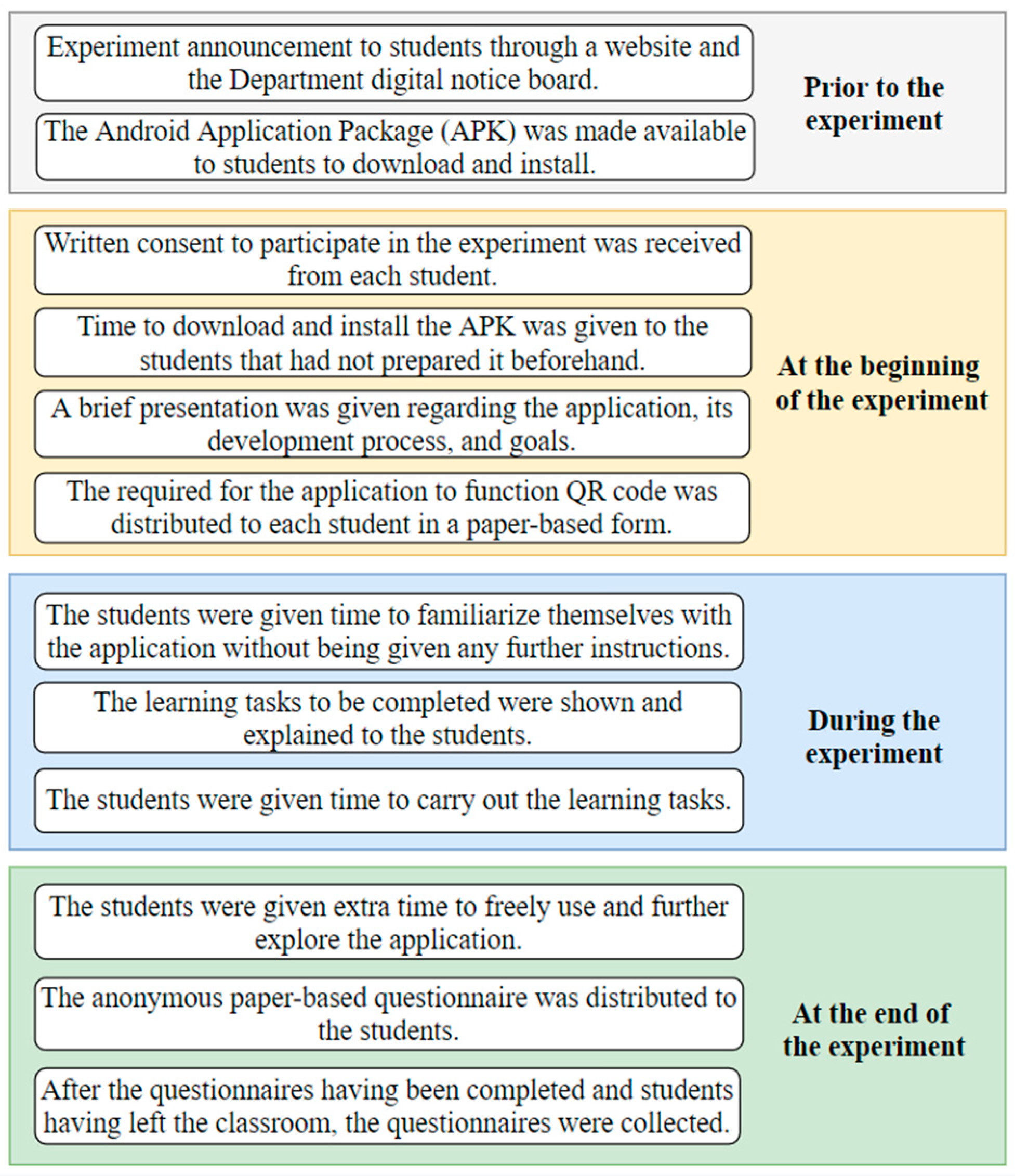


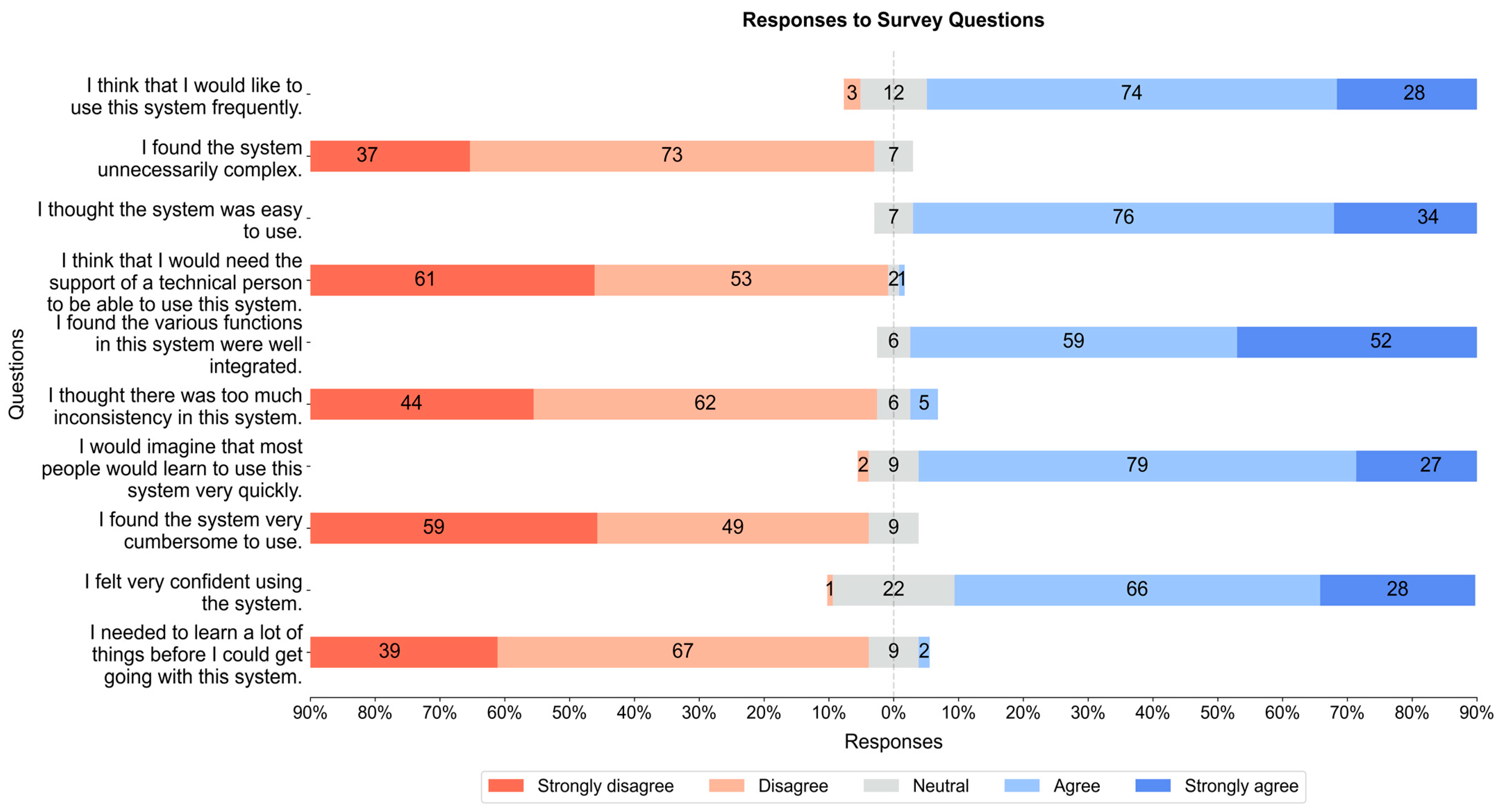
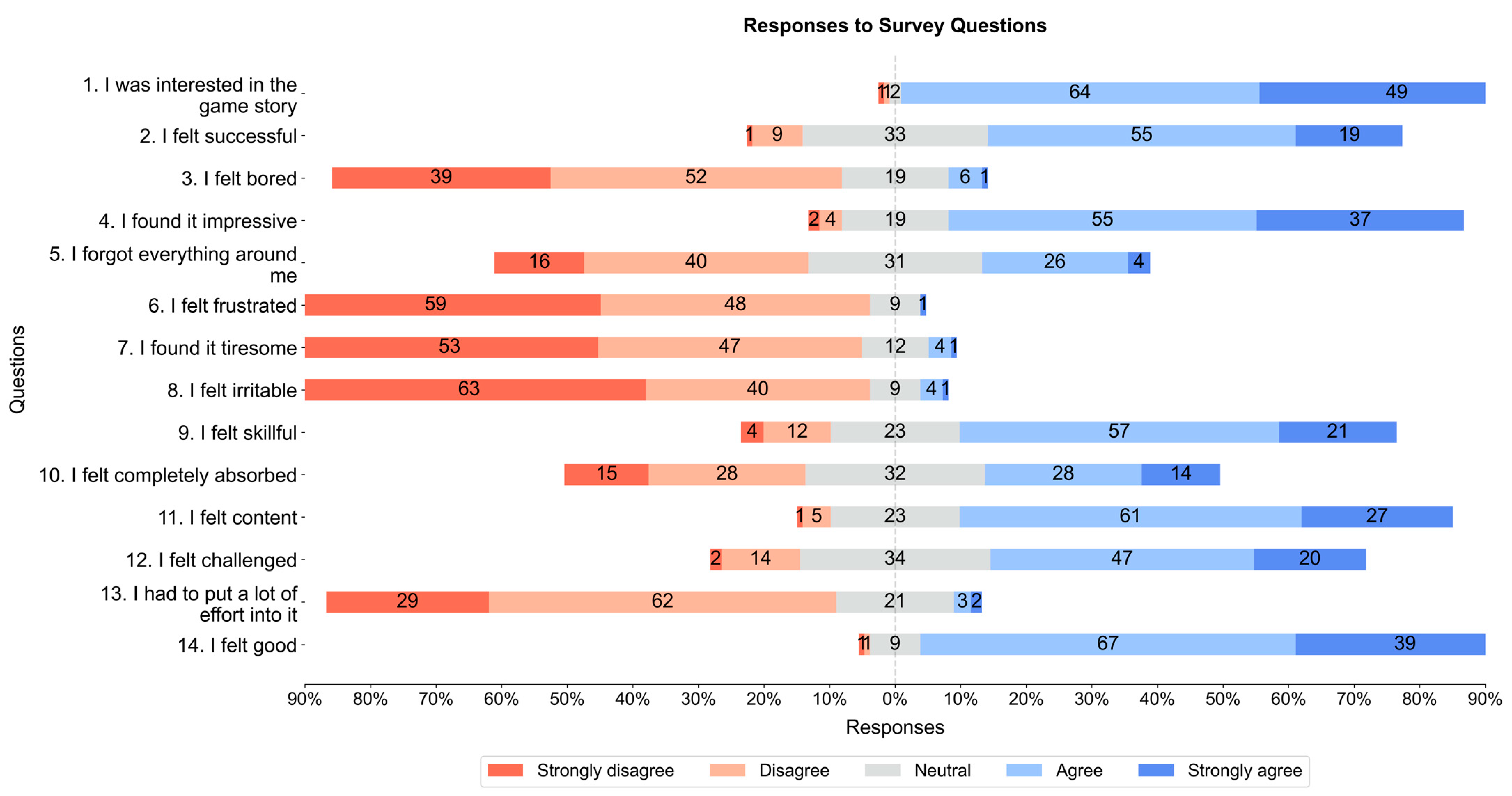

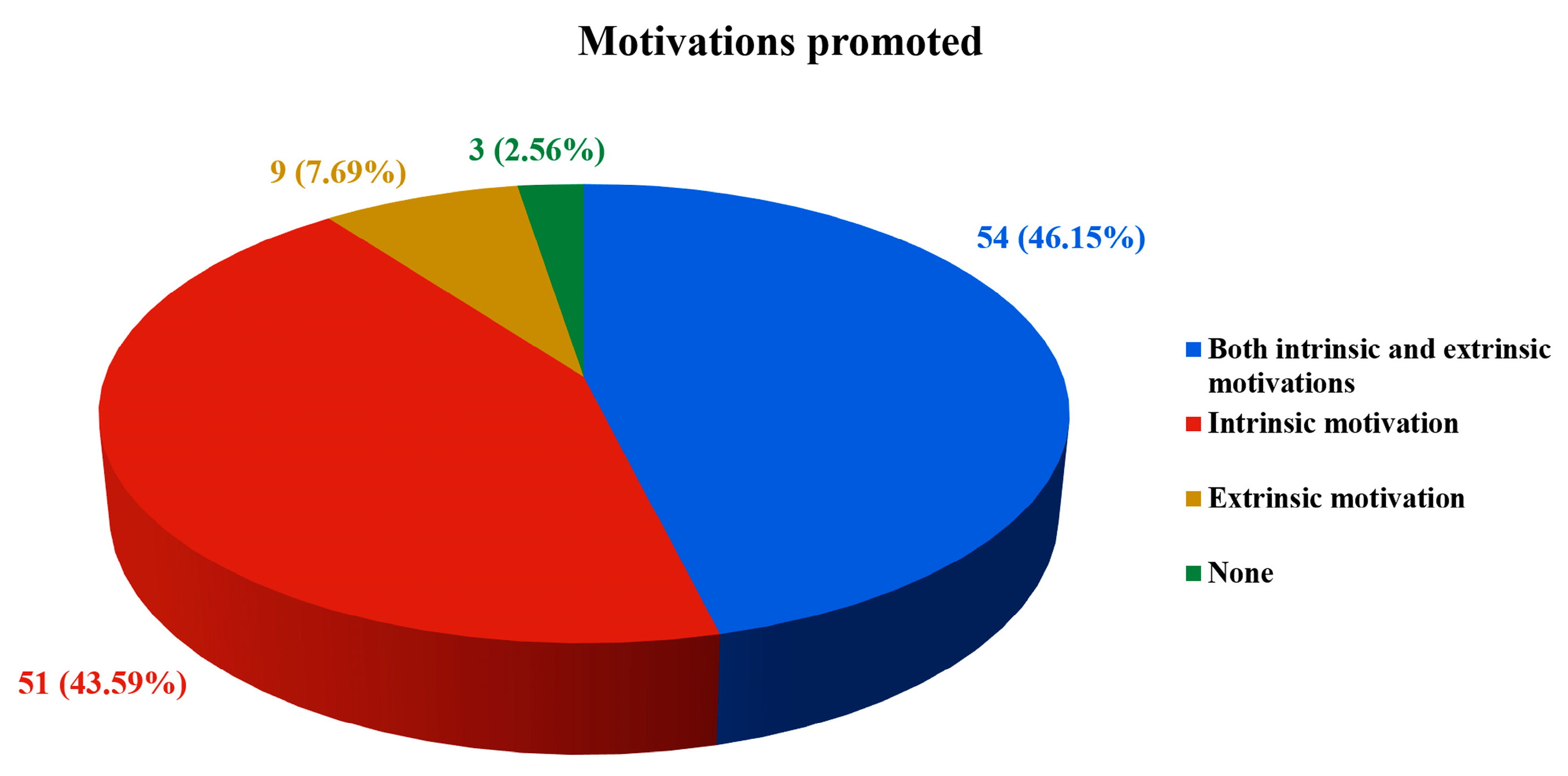

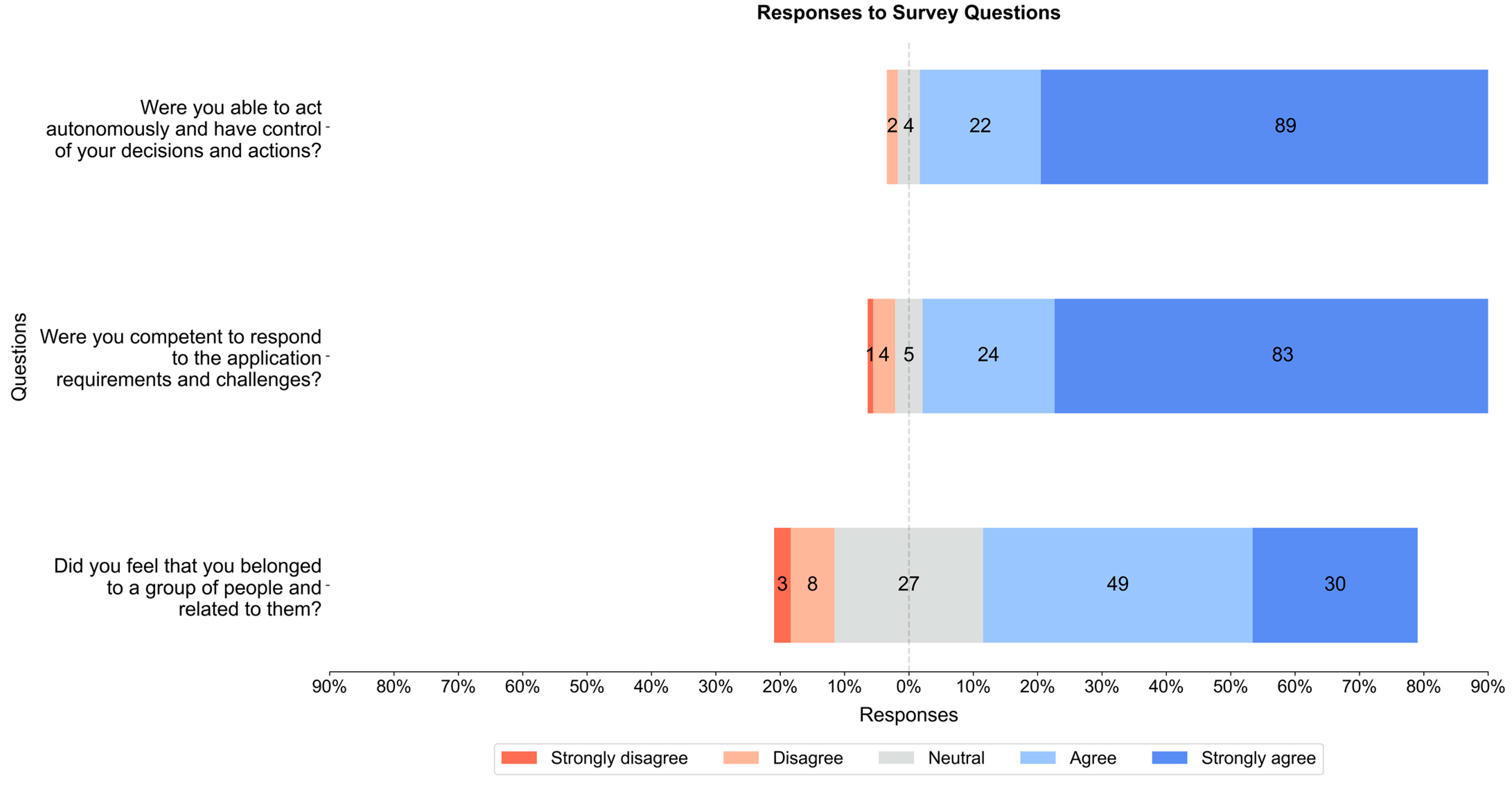
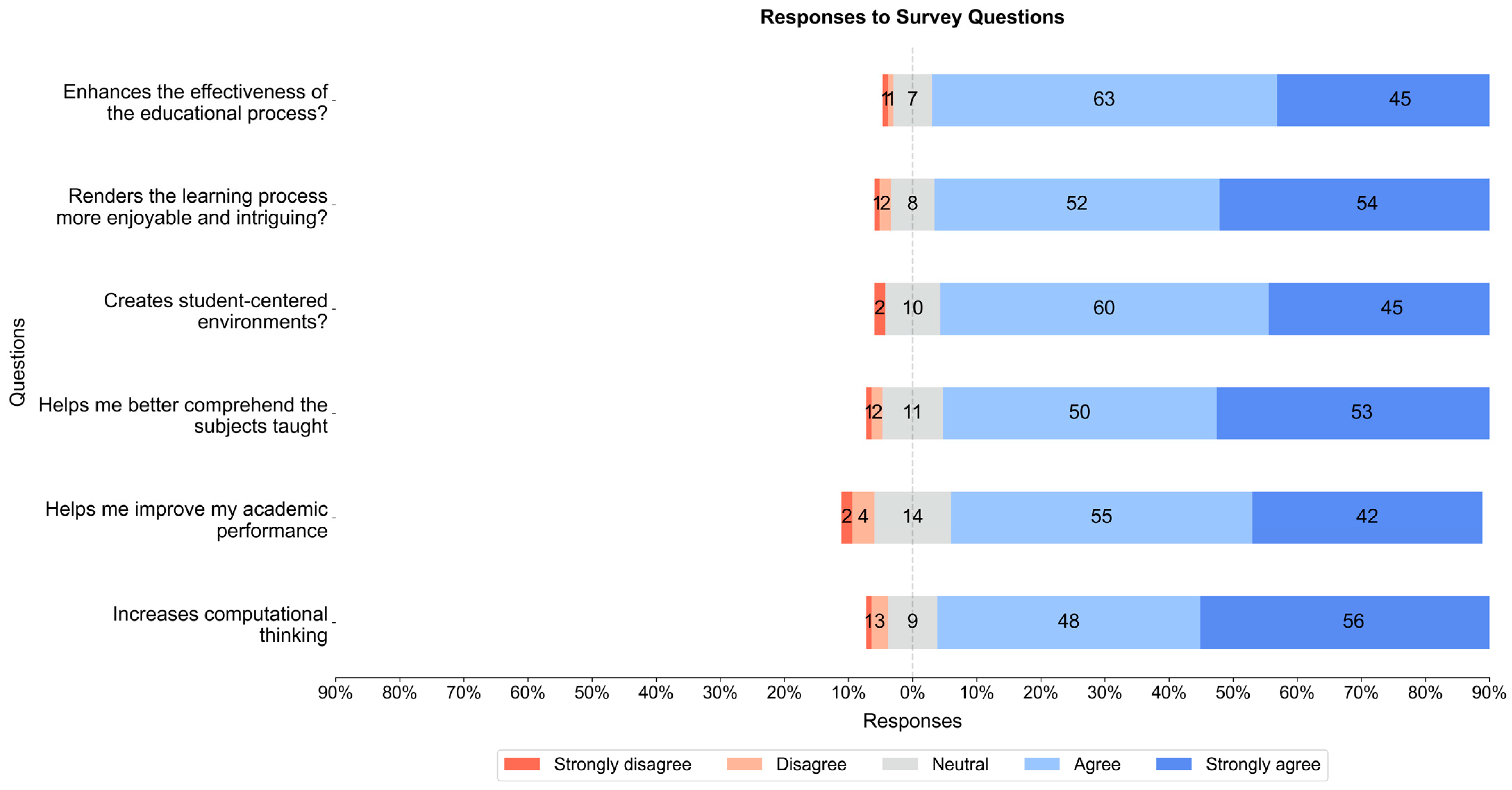
| Question | Strongly Disagree | Disagree | Neutral | Agree | Strongly Agree | Means | Standard Deviation |
|---|---|---|---|---|---|---|---|
| 1. I think that I would like to use this system frequently. | 0 (0.00%) | 3 (2.56%) | 12 (10.26%) | 74 (63.25%) | 28 (23.93%) | 4.09 | 0.66 |
| 2. I found the system unnecessarily complex. | 37 (31.62%) | 73 (62.39%) | 7 (5.98%) | 0 (0.00%) | 0 (0.00%) | 1.74 | 0.56 |
| 3. I thought the system was easy to use. | 0 (0.00%) | 0 (0.00%) | 7 (5.98%) | 76 (64.96%) | 34 (29.06%) | 4.23 | 0.55 |
| 4. I think that I would need the support of a technical person to be able to use this system. | 61 (52.14%) | 53 (45.30%) | 2 (1.71%) | 1 (0.85%) | 0 (0.00%) | 1.51 | 0.58 |
| 5. I found that the various functions in this system were well integrated. | 0 (0.00%) | 0 (0.00%) | 6 (5.13%) | 59 (50.43%) | 52 (44.44%) | 4.39 | 0.59 |
| 6. I thought there was too much inconsistency in this system. | 44 (37.61%) | 62 (52.99%) | 6 (5.13%) | 5 (4.27%) | 0 (0.00%) | 1.76 | 0.74 |
| 7. I would imagine that most people would learn to use this system very quickly. | 0 (0.00%) | 2 (1.71%) | 9 (7.69%) | 79 (67.52%) | 27 (23.08%) | 4.12 | 0.6 |
| 8. I found the system very cumbersome to use. | 59 (50.43%) | 49 (41.88%) | 9 (7.69%) | 0 (0.00%) | 0 (0.00%) | 1.57 | 0.63 |
| 9. I felt very confident using the system. | 0 (0.00%) | 1 (0.85%) | 22 (18.80%) | 66 (56.41%) | 28 (23.93%) | 4.03 | 0.68 |
| 10. I needed to learn a lot of things before I could get going with this system. | 39 (33.33%) | 67 (57.26%) | 9 (7.69%) | 2 (1.71%) | 0 (0.00%) | 1.78 | 0.66 |
| Question | Strongly Disagree | Disagree | Neutral | Agree | Strongly Agree | Means | Standard Deviation |
|---|---|---|---|---|---|---|---|
| 1. I was interested in the game story | 1 (0.85%) | 1 (0.85%) | 2 (1.71%) | 64 (54.70%) | 49 (41.88%) | 4.36 | 0.65 |
| 2. I felt successful | 1 (0.85%) | 9 (7.69%) | 33 (28.21%) | 55 (47.01%) | 19 (16.24%) | 3.7 | 0.86 |
| 3. I felt bored | 39 (33.33%) | 52 (44.44%) | 19 (16.24%) | 6 (5.13%) | 1 (0.85%) | 1.96 | 0.88 |
| 4. I found it impressive | 2 (1.71%) | 4 (3.42%) | 19 (16.24%) | 55 (47.01%) | 37 (31.62%) | 4.03 | 0.88 |
| 5. I forgot everything around me | 16 (13.68%) | 40 (34.19%) | 31 (26.50%) | 26 (22.22%) | 4 (3.42%) | 2.68 | 1.07 |
| 6. I felt frustrated | 59 (50.43%) | 48 (41.03%) | 9 (7.69%) | 0 (0.00%) | 1 (0.85%) | 1.6 | 0.71 |
| 7. I found it tiresome | 53 (45.30%) | 47 (40.17%) | 12 (10.26%) | 4 (3.42%) | 1 (0.85%) | 1.74 | 0.84 |
| 8. I felt irritable | 63 (53.85%) | 40 (34.19%) | 9 (7.69%) | 4 (3.42%) | 1 (0.85%) | 1.63 | 0.84 |
| 9. I felt skillful | 4 (3.42%) | 12 (10.26%) | 23 (19.66%) | 57 (48.72%) | 21 (17.95%) | 3.68 | 1 |
| 10. I felt completely absorbed | 15 (12.82%) | 28 (23.93%) | 32 (27.35%) | 28 (23.93%) | 14 (11.97%) | 2.98 | 1.22 |
| 11. I felt content | 1 (0.85%) | 5 (4.27%) | 23 (19.66%) | 61 (52.14%) | 27 (23.08%) | 3.92 | 0.82 |
| 12. I felt challenged | 2 (1.71%) | 14 (11.97%) | 34 (29.06%) | 47 (40.17%) | 20 (17.09%) | 3.59 | 0.97 |
| 13. I had to put a lot of effort into it | 29 (24.79%) | 62 (52.99%) | 21 (17.95%) | 3 (2.56%) | 2 (1.71%) | 2.03 | 0.83 |
| 14. I felt good | 1 (0.85%) | 1 (0.85%) | 9 (7.69%) | 67 (57.26%) | 39 (33.33%) | 4.21 | 0.69 |
| Component | First Item | Second Item | Total | |||
|---|---|---|---|---|---|---|
| AVG | SD | AVG | SD | AVG | SD | |
| Competence (GEQ items 1 and 9) | 3.70 | 0.86 | 3.68 | 1.00 | 3.69 | 0.93 |
| Sensory and imaginative immersion (GEQ items 1 and 4) | 4.36 | 0.65 | 4.03 | 0.88 | 4.20 | 0.79 |
| Flow (GEQ items 5 and 10) | 2.68 | 1.07 | 2.98 | 1.22 | 2.83 | 1.16 |
| Tension (GEQ items 6 and 8) | 1.60 | 0.71 | 1.63 | 0.84 | 1.62 | 0.77 |
| Challenge (GEQ items 12 and 13) | 3.59 | 0.97 | 2.03 | 0.83 | 2.81 | 1.19 |
| Negative affect (GEQ items 3 and 7) | 1.96 | 0.88 | 1.74 | 0.84 | 1.85 | 0.87 |
| Positive affect (GEQ items 11 and 14) | 3.92 | 0.82 | 4.21 | 0.69 | 4.07 | 0.77 |
| Question | Strongly Disagree | Disagree | Neutral | Agree | Strongly Agree | Means | Standard Deviation |
|---|---|---|---|---|---|---|---|
| 1. I felt revived | 1 (0.85%) | 16 (13.68%) | 49 (41.88%) | 44 (37.61%) | 7 (5.98%) | 3.34 | 0.82 |
| 2. I felt bad | 65 (55.56%) | 49 (41.88%) | 2 (1.71%) | 0 (0.00%) | 1 (0.85%) | 1.49 | 0.62 |
| 3. I felt guilty | 74 (63.25%) | 42 (35.90%) | 0 (0.00%) | 0 (0.00%) | 1 (0.85%) | 1.39 | 0.59 |
| 4. I felt like a winner | 4 (3.42%) | 9 (7.69%) | 31 (26.50%) | 48 (41.03%) | 25 (21.37%) | 3.69 | 1 |
| 5. I found it a waste of time | 60 (51.28%) | 43 (36.75%) | 11 (9.40%) | 2 (1.71%) | 1 (0.85%) | 1.64 | 0.79 |
| 6. I felt energized | 0 (0.00%) | 9 (7.69%) | 31 (26.50%) | 61 (52.14%) | 16 (13.68%) | 3.72 | 0.8 |
| 7. I felt satisfied | 1 (0.85%) | 1 (0.85%) | 17 (14.53%) | 73 (62.39%) | 25 (21.37%) | 4.03 | 0.69 |
| 8. I felt that I could have done more useful things | 28 (23.93%) | 45 (38.46%) | 25 (21.37%) | 14 (11.97%) | 5 (4.27%) | 2.34 | 1.1 |
| 9. I felt powerful | 6 (5.13%) | 27 (23.08%) | 46 (39.32%) | 28 (23.93%) | 10 (8.55%) | 3.08 | 1.01 |
| 10. I felt regret | 70 (59.83%) | 40 (34.19%) | 5 (4.27%) | 2 (1.71%) | 0 (0.00%) | 1.48 | 0.66 |
| 11. I felt ashamed | 82 (70.09%) | 30 (25.64%) | 4 (3.42%) | 0 (0.00%) | 1 (0.85%) | 1.36 | 0.64 |
| 12. I felt proud | 3 (2.56%) | 13 (11.11%) | 41 (35.04%) | 48 (41.03%) | 12 (10.26%) | 3.45 | 0.91 |
| Question | Strongly Disagree | Disagree | Neutral | Agree | Strongly Agree | Means | Standard Deviation |
|---|---|---|---|---|---|---|---|
| 1. Were you able to act autonomously and have control of your decisions and actions? | 0 (0.00%) | 2 (1.71%) | 4 (3.42%) | 22 (18.80%) | 89 (76.07%) | 4.69 | 0.62 |
| 2. Were you competent in responding to the application requirements and challenges? | 1 (0.85%) | 4 (3.42%) | 5 (4.27%) | 24 (20.51%) | 83 (70.94%) | 4.57 | 0.8 |
| 3. Did you feel that you belonged to a group of people and related to them? | 3 (2.56%) | 8 (6.84%) | 27 (23.08%) | 49 (41.88%) | 30 (25.64%) | 3.81 | 0.98 |
| Question | Strongly Disagree | Disagree | Neutral | Agree | Strongly Agree | Means | Standard Deviation |
|---|---|---|---|---|---|---|---|
| 1. Enhances the effectiveness of the educational process? | 1 (0.85%) | 1 (0.85%) | 7 (5.98%) | 63 (53.85%) | 45 (38.46%) | 4.28 | 0.69 |
| 2. Renders the learning process to be more enjoyable and intriguing? | 1 (0.85%) | 2 (1.71%) | 8 (6.84%) | 52 (44.44%) | 54 (46.15%) | 4.33 | 0.75 |
| 3. Creates student-centered environments? | 2 (1.71%) | 0 (0.00%) | 10 (8.55%) | 60 (51.28%) | 45 (38.46%) | 4.25 | 0.75 |
| 4. Helps me better comprehend the subjects taught | 1 (0.85%) | 2 (1.71%) | 11 (9.40%) | 50 (42.74%) | 53 (45.30%) | 4.3 | 0.78 |
| 5. Helps me improve my academic performance | 2 (1.71%) | 4 (3.42%) | 14 (11.97%) | 55 (47.01%) | 42 (35.90%) | 4.12 | 0.87 |
| 6. Increases computational thinking | 1 (0.85%) | 3 (2.56%) | 9 (7.69%) | 48 (41.03%) | 56 (47.86%) | 4.32 | 0.8 |
Disclaimer/Publisher’s Note: The statements, opinions and data contained in all publications are solely those of the individual author(s) and contributor(s) and not of MDPI and/or the editor(s). MDPI and/or the editor(s) disclaim responsibility for any injury to people or property resulting from any ideas, methods, instructions or products referred to in the content. |
© 2023 by the authors. Licensee MDPI, Basel, Switzerland. This article is an open access article distributed under the terms and conditions of the Creative Commons Attribution (CC BY) license (https://creativecommons.org/licenses/by/4.0/).
Share and Cite
Lampropoulos, G.; Keramopoulos, E.; Diamantaras, K.; Evangelidis, G. Integrating Augmented Reality, Gamification, and Serious Games in Computer Science Education. Educ. Sci. 2023, 13, 618. https://doi.org/10.3390/educsci13060618
Lampropoulos G, Keramopoulos E, Diamantaras K, Evangelidis G. Integrating Augmented Reality, Gamification, and Serious Games in Computer Science Education. Education Sciences. 2023; 13(6):618. https://doi.org/10.3390/educsci13060618
Chicago/Turabian StyleLampropoulos, Georgios, Euclid Keramopoulos, Konstantinos Diamantaras, and Georgios Evangelidis. 2023. "Integrating Augmented Reality, Gamification, and Serious Games in Computer Science Education" Education Sciences 13, no. 6: 618. https://doi.org/10.3390/educsci13060618
APA StyleLampropoulos, G., Keramopoulos, E., Diamantaras, K., & Evangelidis, G. (2023). Integrating Augmented Reality, Gamification, and Serious Games in Computer Science Education. Education Sciences, 13(6), 618. https://doi.org/10.3390/educsci13060618











